The History Of Nissan Primera

The Nissan Primera is a large family car produced by the Japanese automaker Nissan for the domestic and European markets.
See also Infiniti G20Since 1986, Nissan had been building Bluebirds—it was essentially a rebadged home-market Auster/ Stanza – for the European market at its factory in Washington, Tyne and Wear, England.
In the autumn of 1990, Nissan replaced the UK Bluebird with the Primera. It had a conventional front-wheel drive chassis and five-speed manual gearbox, with some versions getting the option of a four-speed automatic. Power came from 1.6-litre carburetor and 1.8-litre and 2.0-litre injection gasoline engines; a 2.0-litre diesel followed from 1992 onwards. The 1.8-litre version was never sold in Europe. Bodystyles were four- and five-door saloons and five-door estate (the last of which was imported from Japan).
Nissan had deliberately targeted the car at the European market. The Primera saw Nissan's multi-link front suspension applied to front-wheel drive for the first time. The 2.0-litre gasoline engine received a power upgrade in 1992 which gave the then eZX, (later renamed the eGT) 150 bhp from the standard 2.0-litre engine and a top speed of around 219 km/ h (or 137 mph).
Some five-door UK Primeras were exported back to Japan, Russia and Ireland. In the United States, the Japanese-built version of the Primera was rebadged as the Infiniti G20, part of Nissan's upper-scale Infiniti brand. This version sold well in the Canadian market.[citation needed]
Trim levels
The Primera range came in six trim levels at launch: L, LS, LSX, GS, GSX and ZX. The 1.6-litre engine was available in L, LS and LSX trim and the 2.0-litre 115bhp (86kW; 117PS) engine was available in LS, GS and GSX trim. The ZX model had a 2.0-litre 150bhp (112kW; 152PS) engine. From 1992 onwards, the range was facelifted and new L, LX, SLX, SGX and eGT trim levels replaced the original naming scheme. A 2.0-litre diesel version was available from 1992. L cars were basic, and had the 1.6-litre petrol engine only. LX was slightly plusher, but 2.0-litre petrol and diesel versions were also available. SLX was the mid-range model, and this also had a choice of 1.6 and 2.0 petrol, or 2.0 diesel engines. The SGX trim level was the luxury specification version; powered by the 2.0-litre 115bhp (86kW; 117PS) engine. The eGT was the sporting version, with a 2.0-litre 150bhp (112kW; 152PS) engine. Engine power was slightly increased in mid-1993 with the 1.6 model now producing 102bhp (76kW; 103PS) and the 2.0 model, 123bhp (92kW; 125PS).
From 1994, the range received another facelift, and the trim levels were (almost) the same; although Equation replaced the basic L as the entry-level trim; like its predecessor, it had a 1.6 petrol engine, but there was no diesel option. At this time, SE also replaced SGX. A new "hot hatch" version, the SRi joined the line-up from 1995, and this had a choice of 1.6- or 2.0-litre petrol engines.
See also Infiniti G20The second-generation Nissan Primera was launched in late 1995 in Japan and in the autumn of 1996 in Europe. Unique in its class, new Primera featured multi-link beam rear suspension with multi-link front suspension.
As before, in the UK and Europe the Primera was sold with 1.6 L and 2.0 L petrol engines and a 2.0 L diesel, with liftback, saloon and estate bodystyles. While the estate was now based on the Primera's platform, it was assigned a model code of WP11.
In Japan the Primera was initially offered with the SR18DE and SR20DE engines, and initially only as a sedan. The UK assembled liftback was available only with the SR20DE engine and automatic transmission and began production from November 1997. Estate began production from September 1997.
Alongside the original Primera, the Nissan Primera Camino was launched as a badge-engineered model for different dealer networks. The Japanese models also introduced a CVT automatic transmission during the P11 series, including a six speed tiptronic version in the M6 wagon.
Nissan continued selling the Primera in the United States as the Infiniti G20, using the same grille and rear lamp alterations from the Primera Camino.
In 1998 Nissan New Zealand released a limited edition Primera SMX with association with Steve Millen (Stillen Sports Parts). Features include cross drilled brakes, Eibach springs and a more aggressive body kit. There were a total of 24 made in 4 colour choices. This was because until 1998 (due to lifting of import tariffs on cars) Nissan New Zealand had an automotive assembly operation, and for a short time between 1997 and 1998 the P11 Primera was assembled there.
The Primera won the British Touring Car Championship manufacturers and team titles thanks to RML in 1998 and, in 1999 won manufacturer and team titles plus first and second place in the championship with Laurent Aïello and David Leslie at the wheel of the factory-sponsored team. Privateer Matt Neal with backing from the factory took the Independents Cup in 1999 and 2000.
To celebrate the two victories in 1998, Nissan UK released a limited edition of 400 'GTSE' Models, with 16" AZEV alloy wheels, two-tone 'flip' ChromaFlair "Mystic" green paint, following the special theme to the interior which featured full leather seating with green piping seats, steering wheel and a Momo gearknob. To celebrate the 1999 "clean sweep" they released a limited edition 'GTLE' model with 16" multi-spoke Enkei alloy wheels, full leather interior with silver piping, Momo gearknob and a colour choice of flame red, kuro black, starburst silver, and Nordic blue.
The P11 is a very nice car to modify, with many suppliers of performance parts around the world.
In the autumn of 1999, Nissan gave the Primera a facelift, giving it a more modern, front end with clear style headlamps featuring projector units—instead of the traditional Fresnel lens type. Nissan also introduced their "corporate identity" front, with the "flying wing" grille. The new code-name for this model was "P11-144".
Along with the exterior changes, improved specification levels were present; with the entry level models such as the "S" featuring automatic climate control, driver, passenger, and side airbags. Further up the model range, other features were seen such as Xenon headlamps.
A new "lean burn" 1.8 L petrol engine, the QG18DE was added to the range. This facelift was not generally applied outside Europe, with Nissan "formalized" the fronts of other Primeras and Caminos instead, bringing them into line with the look of the American Infiniti model.
The Nissan Primera STCC Edition
Only 100 of them were made. It had the same engine as the Primera Sport, but it was lowered 25mm (1.0in) and had a bigger wing.
In December 2001, Nissan introduced the third-generation Nissan Primera, its first all-new car since the alliance with Renault was formed two years earlier. The new Primera is more radically styled than previous versions. No Infiniti equivalent was released; the Nissan Skyline-based Infiniti G35 replaced the G20 in the United States.
New Zealand Primeras are all equipped with continuously variable transmission; there is no manual option. The CVT is also available in the European 2.0L and the Japanese 2.0/ 2.5L (an engine not available in Europe). In that market the saloon was the mainstream model, until 2006 when the liftback variant supplanted it.
Falling sales saw the Primera withdrawn from sale in the UK at the end of 2006, though production will continue for export markets until the launch of its successor before the end of the decade.
The 2.0 L 6-Speed Manual Nissan Primera 20V has Nissan's SR20VE Neo VVL engine with Variable Valve Lift and Timing. It produces 150 kW (204 PS) of power at 7200 rpm and 206 N·m (21.0 kgf·m) of torque at 5200 rpm.
From Wikipedia, the free encyclopedia
More About Nissan Primera
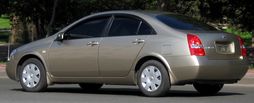
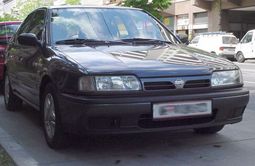
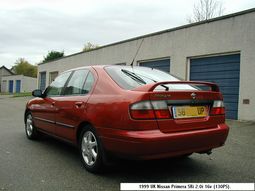
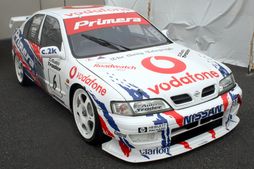
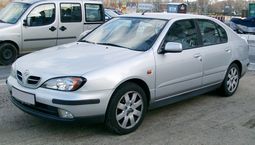
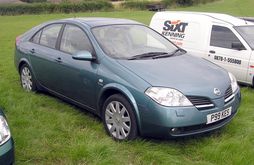
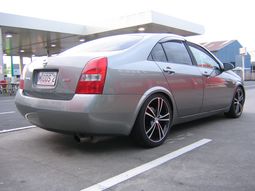
|